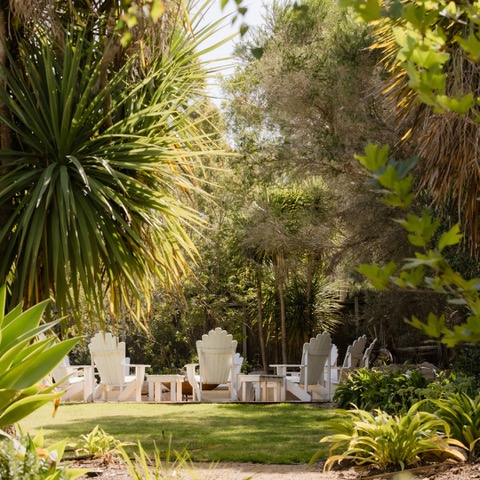
Wellness and business retreat trends for 2026: What to expect
20 October 2025Hosting your first retreat can feel both thrilling and overwhelming. You’re creating something meaningful. An experience that blends transformation, relaxation and connection. Additionally, it provides a space where people can pause, reset and grow.
However, if you’re stepping into this role for the first time, know that hosting your first retreat doesn’t mean doing it alone. Whether you’re planning a wellness weekend, a yoga retreat, or a creative getaway, a successful retreat requires intentional planning and heart-centred leadership.
Summer House Retreat has supported many facilitators through their first retreat. We help turn inspired ideas into experiences that leave a lasting impact. In this blog, we go through 12 steps that will help you host your first retreat with clarity and confidence.
1. Clarify your “why” as a retreat host
Every retreat begins with purpose. Whether it’s a wellness retreat, yoga retreat or business retreat, take time to reflect on what drives you to host and what transformation you want your guests to experience.
When you start, ask yourself:
- Why do I want to host this retreat?
- Why should people choose this experience over others?
- What transformation do I want participants to experience?
When your “why” is clear, everything else falls into place. Your “why” should also include your location and messaging.
2. Define your ideal attendee
Secondly, understanding your audience is key. Ask yourself, “Are you welcoming busy professionals, creatives, or entrepreneurs?” Each group will have different needs, expectations, and goals.
Knowing your guests helps you shape the retreat’s tone, pricing, and content. As a retreat or wellness facilitator, this step ensures your retreat speaks directly to those you’re here to serve.
3. Choose a theme or focus
A clear theme gives your retreat direction and energy. Additionally, it tells people what the experience is about and what they can expect.
Some ideas include:
- Renew & Reset
- The Aligned Entrepreneur
- Mindful Living
- The Beauty in Boundaries
- Finding Your Joy
As a result, your theme will help guide your content. Themes help to set the tone and strengthen your marketing message.
4. Plan the logistics
Once you have clarity on your audience and purpose, it’s time to set your retreat in motion.
First, choose a season and confirm your dates. Think about how the time of year reflects your retreat’s intention. For example, spring supports renewal, autumn is ideal for reflection, and winter encourages deep rest.
Planning ahead also gives your guests time to prepare and increases the chances of booking.
5. The retreat equation: budget = costs + revenue goals
Budgeting may not feel exciting, but it’s essential for hosting your first retreat with ease.
Start with a simple spreadsheet. For example, a budget spreadsheet may include:
- Venue hires and inclusions
- Catering and staff
- Marketing, design, and photography
- Welcome gifts and materials
- Guest facilitators or wellness providers
- Transportation, if required
- A small buffer for unexpected costs
Then, map out your income:
- Number of attendees x price
- Optional upsells (private sessions, merchandise, etc.)
- Early-bird vs. standard pricing
Knowing your breakeven point allows you to adjust pricing or expenses before launch. With your budget set, you’ll feel confident your retreat is both accessible and profitable.
6. Find your perfect venue
The venue sets the tone. Think about what you want your guests to feel. Calm, inspired, or connected to nature. Summer House Retreat offers a purpose-built space by the coast, surrounded by gardens, with plenty of space for group sessions and quiet reflection.
When choosing a venue, check inclusions, accessibility, guest comfort, and atmosphere. As a result, these details shape the entire retreat experience.
7. Design your schedule to support your guests
Your schedule should balance learning activities with stillness. It should include a mixture of activities and sessions.
For example, this may include:
- Workshops and group sessions
- Journaling and reflection
- Movement and mindfulness
- Free time
- Nature walks
As a retreat facilitator, your goal is to help guests feel supported and not overwhelmed. As a result, a thoughtful flow keeps energy steady and guests grounded.
8. Build a supportive team
You don’t have to lead alone. In fact, it is an excellent strategy to bring people who support your vision and help create ease. For example, a support person may be:
- A wellness chef
- Yoga or meditation guide
- Photographer
- Co-facilitator
When you collaborate with local professionals, it can elevate your retreat and allow you to stay fully present with your group.
9. Create transformational content and a beautiful retreat landing page
Design sessions that build on each other. Mix teaching, rest, and experiences so guests walk away with something that’s had a lasting impact.
Your retreat landing page should be clear and engaging. For example, your landing page may include:
- Visuals of the space
- An outline of the experience
- Testimonials from past clients or participants
- Details on food, location, and inclusions
- An easy booking process
It’s important to note that first impressions matter. The more aligned your page is, the easier it becomes to attract the right guests.
10. Make registration and payments simple
Choose a reliable payment system and form submission system. For example, Stripe, PayPal or Square are all easy options.
Additionally, automate confirmations and reminders. As a result, it helps guests feel supported from booking to arrival. Moreover, the simpler it is to join, the more likely people will commit.
11. Market with heart and authenticity
When you are authentic with your content, it draws people in. Tell your story and share your “why”.
Firstly, just start with your community. Use email, social media, and referrals. Then, open up to wider circles. Share:
- Sneak peeks of the venue and experience
- Personal insights about your “why”
- Photos or short videos from behind the scenes
People book retreats for a multitude of reasons, and rarely is it just because of the schedule. Many individuals book because of how they want to feel, so embrace this!
12. Prepare for the unexpected and keep the connection alive
Finally, it’s essential to understand that things may not go perfectly. For example, weather, travel delays and last-minute adjustments are all out of your control, so plan for these moments and stay grounded. Your presence matters far more than perfection.
After your retreat, express your gratitude to your attendees. This could be by sending a thank-you message or sharing a photo gallery. Inviting continued connection helps keep the energy alive.
Example:
“Thank you for being part of our retreat. Your presence made it truly special. We’ve uploaded some photos so you can relive the moments, and we’d love for you to stay connected for future gatherings.”
Retreat facilitators who build a community turn one-time guests into lifelong supporters.
Ready to Start Hosting Your First Retreat?
Hosting your first retreat is a challenge, however, it’s one of the most rewarding experiences you can offer. It takes planning, trust, and a real passion for what you do. That is why, with the right team and the right space, you can create something unforgettable.
Summer House Retreat is here to guide and support you. So, if you’re ready to bring your first retreat to life, book a private call with Debbie Fowler, and let’s begin your adventure.



